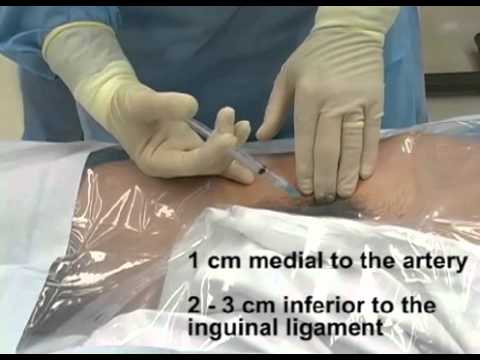ANATOMY
Femoral vein
The femoral vein lies within the femoral sheath and courses under the inguinal ligament; it then becomes the external iliac artery.
The vein is located approximately 1 cm medial to the femoral artery.
The femoral nerve is lateral to the vein.
Needle entry occurs 2 to 3 cm inferior to the inguinal ligament, 1 cm medial to the femoral artery pulsation.
Central venous lines are essential tools in the care of complicated patients, both on inpatient wards and in the emergency department and intensive care unit. They may provide access for blood draws, facilitate central administration of fluids and medications, and allow direct measurement of cardiac filling pressure.
Unfortunately, central lines are associated with serious complications, including nosocomial bloodstream infections. Recent data suggest that of the more than 200,000 such infections each year, 90% are due to central lines. One can minimize patient risk by practicing proper sterile technique during line insertion, maintaining adequate occlusive dressings, and removing all unnecessary lines as soon as possible.
The three main approaches used to place central lines are the internal jugular, subclavian, and femoral. This chapter reviews the subclavian approach; other sites are detailed in separate chapters
INDICATIONS
Administration of agents into the central vasculature
Central venous access is required to administer certain medications, including most vasoactive and/or inotropic agents (i.e., vasopressors such as dopamine and norepinephrine). In addition to expediting delivery of these drugs to the heart and arterial system, central administration decreases the risk of damaging peripheral tissue from the vasoconstrictive effects of the medications.
Patients needing total parenteral nutrition also require central access because the osmolarity of the mixture exceeds what can safely be administered into the peripheral circulation.
Other hyperosmolar agents that are optimally infused through a central line include concentrated potassium solutions, hypertonic saline solutions, certain chemotherapeutic agents, and calcium chloride.
Central circulation and intracardiac access
Measurement of central venous filling pressure within the right atrium can be helpful in determining the volume status of a patient and can readily be transduced via a central venous catheter in the internal jugular or subclavian position.
Specialized pulmonary artery (i.e., Swan-Ganz) catheters can be used to measure pulmonary capillary wedge pressure, a means of approximating left-sided filling pressure
Blood drawn from a central catheter can allow the measurement of mixed venous (or central venous) oxygen saturation, often used to estimate cardiac output.
Temporary transvenous pacemakers can be inserted through central venous catheters (more specifically, sheath introducer catheters) to provide a more reliable and comfortable means of pacing than the transcutaneous route.
Maintenance of venous access
In acutely unstable patients, peripheral venous access may be inadequate.
Patients requiring multiple medications in drip formulation can quickly run out of access points.
This problem is compounded in a chronically ill patient, who oftentimes has insufficient peripheral access because of frequent blood drawing and peripheral intravenous (IV) line placement.
Central venous catheters provide reliable access for blood drawing and administration of medications, until either peripheral access can be obtained or less venous access is required.
Hemodialysis and plasmapheresis
Emergency or short-term dialysis and plasmapheresis can be performed via special central venous catheters (e.g., Quinton catheters).
CONTRAINDICATIONS
Absolute contraindications
Adequate peripheral IV access
Operator inexperience
Uncooperative patient
Relative contraindications
Significant uncorrectable bleeding disorder
Contraindications unique to the femoral approach
Filter in the IVC
DVT
Abdominal trauma
INDICATIONS
Administration of agents into the central vasculature
Central circulation and intracardiac access
Maintenance of venous access
Hemodialysis and plasmapheresis
CONTRAINDICATIONS
Absolute contraindications
Adequate peripheral IV access (see Intravenous Cannulation for further details)
Operator inexperience
Uncooperative patient
Relative contraindications
Significant uncorrectable bleeding disorder
Contraindications unique to the femoral approach
Filter in the IVC
DVT
Abdominal trauma
Dr.GABER SAIED MUBARAK
Source




thank you, but there is no sound ! , a central artery cathetirization now please
very intersting and helpfull thanks a lot again
Thank you very much for all of your uploads!
very good & informative
thank you so much!
I've had trouble advancing the dilator. Encountered too much resistance which resulted in kinking of the guidewire and had to remove and chose another site. Any tips on how to avoid this?
Excellent var good effort and aid for teaching. Thanks
nice video thank you ,
i think they should have shave the patient to minimize the risk of infection
Does anyone know how long it takes that wound to heal? My femoral vein area has the strange bump. I only wore the catheter in my leg/private area for about 2 hours. I mashed the white stuff out a week after the procedure. I just want this bump to go away near my private area. I would love to hear anyone's advice.
Hi there, good video. Are you supposed to preload the central line with saline prior to insertion/or aspirate blood from each line? How do you limit the risk of an air embolus?
Great Video
Shave that fucking pussy or penis.
can you measure cvp from a fem line?
very clear demonstration
good demonstration
I Had This Done Recently In The Hospital But I Was Sedated && I Wanted To Know What They Did To Me. Good Vid Explained Perfectly
What country is this? Why wasn't the patient pubic hair shaved? Why does the patient have a smile on his face? I'm having a hard time with watching this video. Next!! ?????
Is it danger if the guide wire does not removed???
Insertion of hemodialysIs catheter
very nice and explained video.good doctor.
i cant find femoral vein.just artery please help Dr.I try left right leg nothing.its posible for the vene go deep
I here because scrubs keeps mentioning this procedure.
Thats a heavy pubic hair….. normally all young guys shave the pibic area…. so i was schocked… i would never put a central line in a area which is so heavy hairy….
Is there any indication that how much cm of the dilator to inserted ????and is there any particular direction towards which the needle to be inserted in the femoral vein or it is just parallal to thigh?????